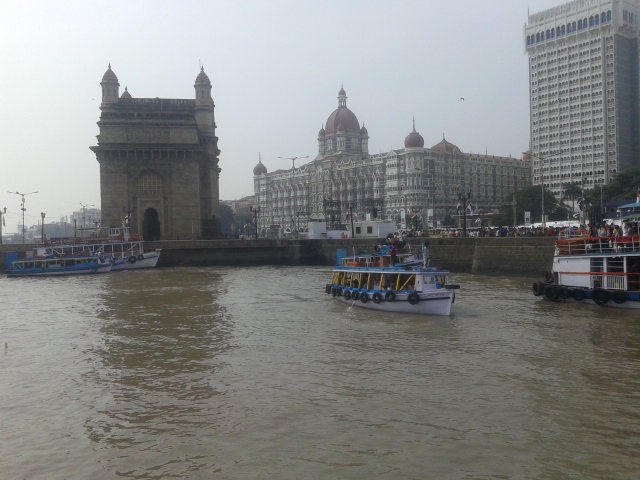
If you want to do the touristic outings in South Mumbai, Elephanta caves are a great place, to begin with. On a Sunday, The Gateway of India is the busiest and a lot crowded. To go to the Elephanta caves, you must take a ferry from The Gateway of India. More than foreigners there are a lot of Indian tourists who especially like to visit the place with friends and family. A sum of 300 rupees is the entry fee for the ferry which is the payment for both the ways.
 The ferry journey is the most beautiful part that one can experience. The open sea surrounded by nothing but calmness. Once you begin the ferry journey, you enter another world filled with nature, serenity away from the busiest and noisy areas of Mumbai. As you go ahead on the ferry, the jammed packed Mumbai filled with traffic and people fades away. Then it’s just the open sea and the birds.
The ferry journey is the most beautiful part that one can experience. The open sea surrounded by nothing but calmness. Once you begin the ferry journey, you enter another world filled with nature, serenity away from the busiest and noisy areas of Mumbai. As you go ahead on the ferry, the jammed packed Mumbai filled with traffic and people fades away. Then it’s just the open sea and the birds.

A flock of birds tries to compete with the speed of the ferry, for the pieces of food thrown by the passengers. As we moved ahead the peaceful paradise and the beauty of the salty sea is disturbed by heavy ships and this reflects that nothing is spared by the human beings.

It takes at least an hour to reach the destination. The ferry consists of varied people of different social background, social status, and ethnicity. Everyone gives a pleasant vibe; far away from the usual life, enjoying with friends, family and loved ones to reach this amazing destination. There are many ferries with diverse names but the one I traveled in is ‘Tasleem’
As the ferry came closer to my destination, from a distance you can see the mountain filled with thick foliage with small villages popping around. Once I reached the destination, there is a pathway leading to the caves and also there are small eatery stalls selling season based fruits and snacks. Thereafter, at the far end of the pathway, there is a mini train which takes passengers from the landing of the ferry till the end of the pathway.
To enter the caves one must to climb flight rocky steps. The Elephanta caves are situated on top of a hill. While climbing can be a tiresome experience, the small kiosks selling apparels, home decors, figurines, artifacts, postcards and much more to distract yourself to reach the caves. Don’t be surprised to see monkeys jumping from place to place all around.

Once I reached that entrance of the caves, a fee is charged for both domestic and international tourist. The caves are perfectly standing tall on the island of Elephanta, which was originally called as Gharapuri which derives its name from a massive stone image of an elephant.
The Elephanta Caves is declared by the Archaeological Survey of India as Monument of National importance in 1909 and henceforth inscribed by the UNESCO as the World Heritage site in 1987.
The cave complex Elephanta comprises total seven caves out of which five are in the lower western side while the other two are at the eastern top of the hillock. From the five caves which are on the lower side, the cave one is exclusively carved with the various manifestation of Lord Shiva. It has a pillared hall with a small shrine and four entrance doors bordered by the guardians. You’ll get to also see the massive yet elegant figures of divinities, guardians and certain architectural features such as the square pillar with cushion capitals suggest the influence of the Chalukyan Empire. Also, the depiction of mountains and clouds and the hairstyles of woman are reminiscent of Gupta art.
The main cave consists of a sanctum and massive hall divided into the five bays. The artistically carved panels on the walls of this cave include the Yogeshwara( Lord of Yoga), Nataraja Shiva ( Cosmic Dancer), ShivaParvati, Ardhanarishvara, Gangadhara, Andhakasuravadha, Ravananugraha Shiva, Kalyansunder Murti and Maheshmurti. The Maheshamurti of Shiva is depicted on the South wall with three aspects of creation, protection, and destruction revealing a masterpiece of Chalukyan Gupta Art.
The ceiling of the main cave is believed to have been originally painted with different colors. There is circular pedestal in the open courtyard signifies the seat of Nandi (Bull) the vehicle of Shiva. The side cave has a small shrine and a Pradaksinapatha ( Circumambulatoty passage) with an interesting panel of Ashtamatrikas ( Eight Mother Goddesses) fringed by Kartikeya and Ganesha.
The other caves are simple and have lesser embellishment. In addition, the antiquarian remains found in the Elephanta Caves are the Stupa of the 3rd century BC. At the top of the hillock, Kshatrapa coins of the 4th century AD and some sculptures including Mahishasumardini, four-headed images of Brahma, Vishnu and Garuda.
The cave just doesn’t have the aesthetic value but also religious as tourist come for sightseeing as well as to worship the Gods. From the top of the caves, the entire scenic view is captivating. It’s completely a worthwhile experience to visit the Island of Elephanta.



